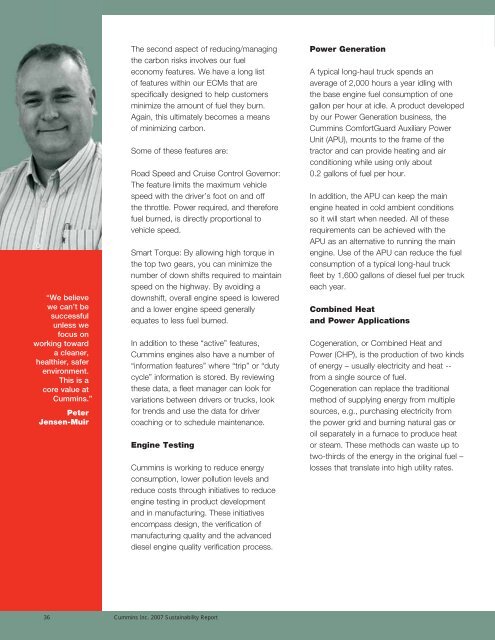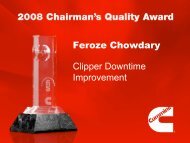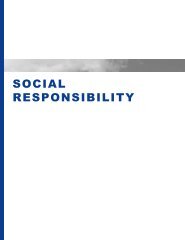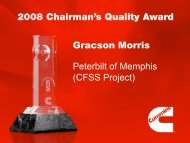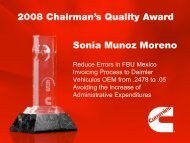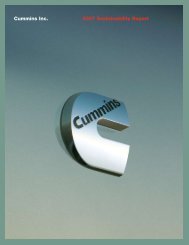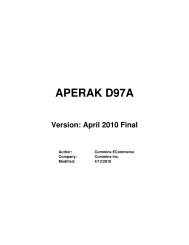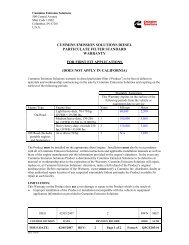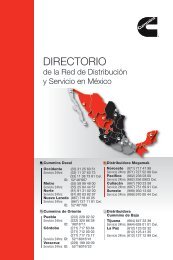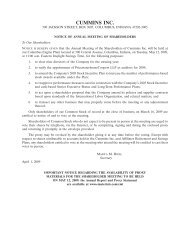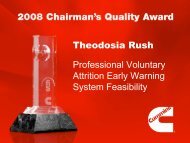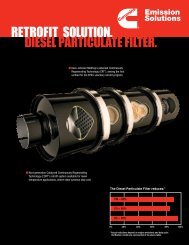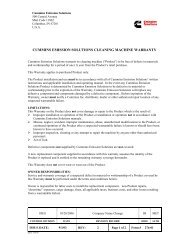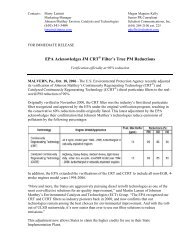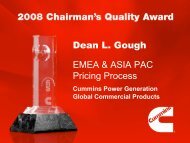Cummins Inc. 2007 Sustainability Report
Cummins Inc. 2007 Sustainability Report
Cummins Inc. 2007 Sustainability Report
Create successful ePaper yourself
Turn your PDF publications into a flip-book with our unique Google optimized e-Paper software.
“We believe<br />
we can’t be<br />
successful<br />
unless we<br />
focus on<br />
working toward<br />
a cleaner,<br />
healthier, safer<br />
environment.<br />
This is a<br />
core value at<br />
<strong>Cummins</strong>.”<br />
Peter<br />
Jensen-Muir<br />
The second aspect of reducing/managing<br />
the carbon risks involves our fuel<br />
economy features. We have a long list<br />
of features within our ECMs that are<br />
specifically designed to help customers<br />
minimize the amount of fuel they burn.<br />
Again, this ultimately becomes a means<br />
of minimizing carbon.<br />
Some of these features are:<br />
Road Speed and Cruise Control Governor:<br />
The feature limits the maximum vehicle<br />
speed with the driver’s foot on and off<br />
the throttle. Power required, and therefore<br />
fuel burned, is directly proportional to<br />
vehicle speed.<br />
Smart Torque: By allowing high torque in<br />
the top two gears, you can minimize the<br />
number of down shifts required to maintain<br />
speed on the highway. By avoiding a<br />
downshift, overall engine speed is lowered<br />
and a lower engine speed generally<br />
equates to less fuel burned.<br />
In addition to these “active” features,<br />
<strong>Cummins</strong> engines also have a number of<br />
“information features” where “trip” or “duty<br />
cycle” information is stored. By reviewing<br />
these data, a fleet manager can look for<br />
variations between drivers or trucks, look<br />
for trends and use the data for driver<br />
coaching or to schedule maintenance.<br />
Engine Testing<br />
<strong>Cummins</strong> is working to reduce energy<br />
consumption, lower pollution levels and<br />
reduce costs through initiatives to reduce<br />
engine testing in product development<br />
and in manufacturing. These initiatives<br />
encompass design, the verification of<br />
manufacturing quality and the advanced<br />
diesel engine quality verification process.<br />
36 <strong>Cummins</strong> <strong>Inc</strong>. <strong>2007</strong> <strong>Sustainability</strong> <strong>Report</strong><br />
Power Generation<br />
A typical long-haul truck spends an<br />
average of 2,000 hours a year idling with<br />
the base engine fuel consumption of one<br />
gallon per hour at idle. A product developed<br />
by our Power Generation business, the<br />
<strong>Cummins</strong> ComfortGuard Auxiliary Power<br />
Unit (APU), mounts to the frame of the<br />
tractor and can provide heating and air<br />
conditioning while using only about<br />
0.2 gallons of fuel per hour.<br />
In addition, the APU can keep the main<br />
engine heated in cold ambient conditions<br />
so it will start when needed. All of these<br />
requirements can be achieved with the<br />
APU as an alternative to running the main<br />
engine. Use of the APU can reduce the fuel<br />
consumption of a typical long-haul truck<br />
fleet by 1,600 gallons of diesel fuel per truck<br />
each year.<br />
Combined Heat<br />
and Power Applications<br />
Cogeneration, or Combined Heat and<br />
Power (CHP), is the production of two kinds<br />
of energy – usually electricity and heat --<br />
from a single source of fuel.<br />
Cogeneration can replace the traditional<br />
method of supplying energy from multiple<br />
sources, e.g., purchasing electricity from<br />
the power grid and burning natural gas or<br />
oil separately in a furnace to produce heat<br />
or steam. These methods can waste up to<br />
two-thirds of the energy in the original fuel –<br />
losses that translate into high utility rates.


